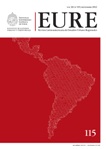Location of Catholic infrastructure, socio-territorial dynamics and geography of religions: The case of Santiago Metropolitan Area, Chile
DOI:
https://doi.org/10.4067/S0250-71612012000300003Keywords:
social inequality, urban fragmentation, socio-territorial transformationsAbstract
Between 2008 and 2009, a team of researchers from the Institute of Geography of the Pontificia Universidad Católica de Chile studied the ways in which the Catholic Church relates itself and contributes to the drawing to the sociospatial landscape in Santiago's Metropolitan Area. It did so by the analysis and interpretation of the localization of Catholic buildings; the socioeconomic base of the inhabitants of those areas; the intercensal variation of the number of Catholics between the years 1992 and 2002; and the founding concepts of that Church in the localization of its infraestructure through the years. Specifically, the objectives of the investigation were to locate and spatialize the Catholic buildings, to characterize and analyze the Catholic population for the 1992-2002 period and to know the guidalines of the Catholic institution for the location of its buildings.
ÍDownloads
Published
How to Cite
Issue
Section
License
Copyright (c) 2012 Revista EURE - Revista de Estudios Urbano Regionales

This work is licensed under a Creative Commons Attribution 4.0 International License.
Al momento de aceptar la publicación de sus artículos, los autores deberán formalizar la cesión de derechos de autor a EURE, según las condiciones establecidas por la Revista.
Ésta establece que el autor autoriza a EURE de manera gratuita, exclusiva e ilimitada a reproducir, editar, publicar, distribuir, publicitar, comercializar y traducir el artículo, a cualquier soporte conocido o por conocer y desarrollar.
Del mismo modo, los autores aseguran que el artículo propuesto es original, no publicado y no propuesto para tal fin a otro medio de difusión.


